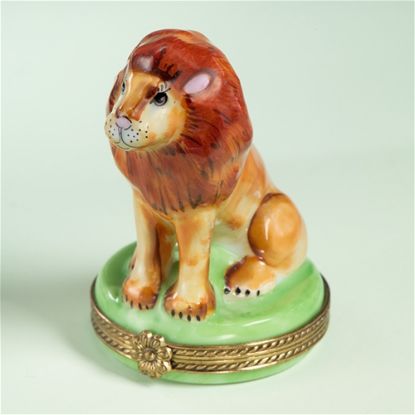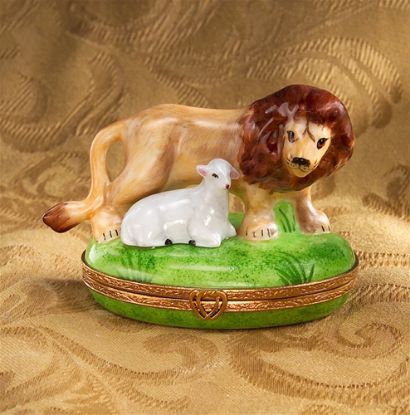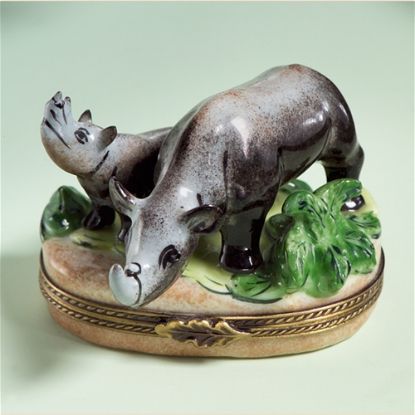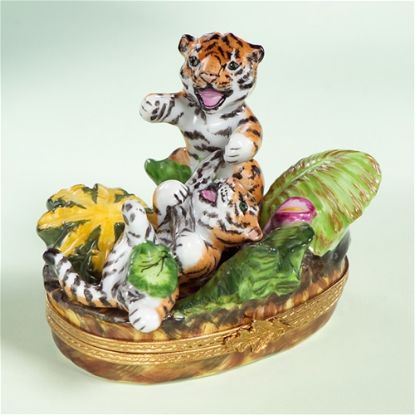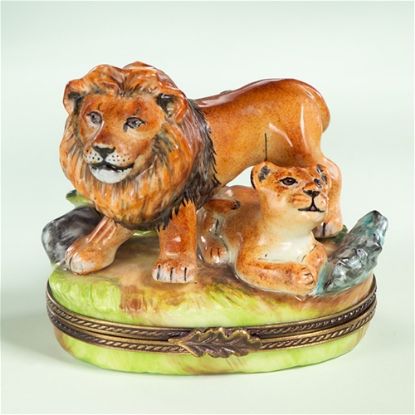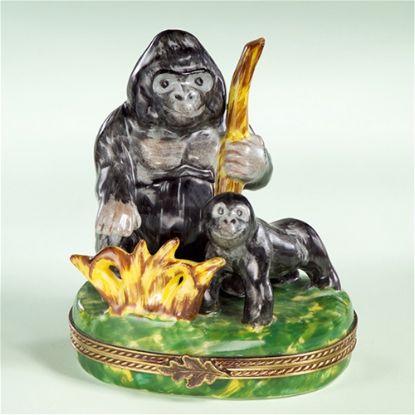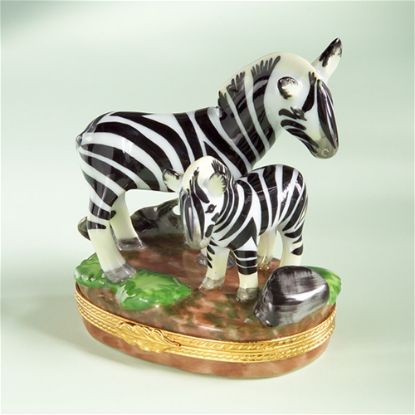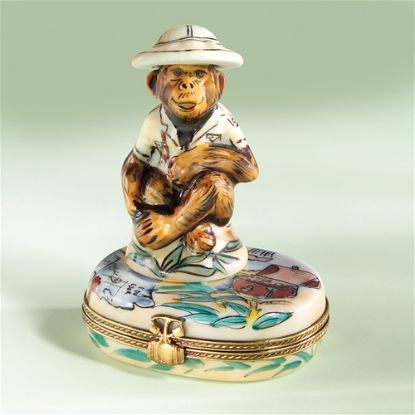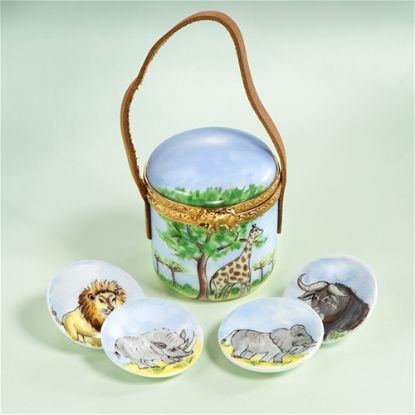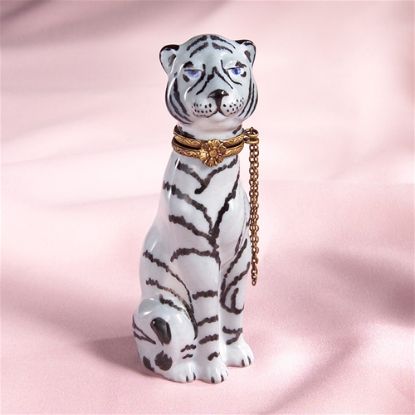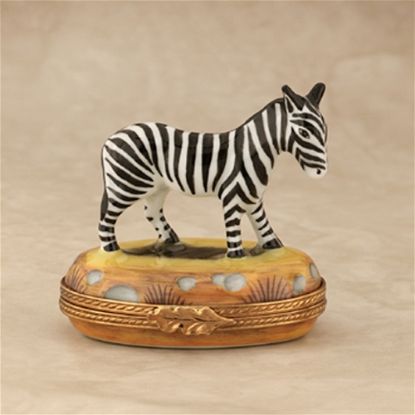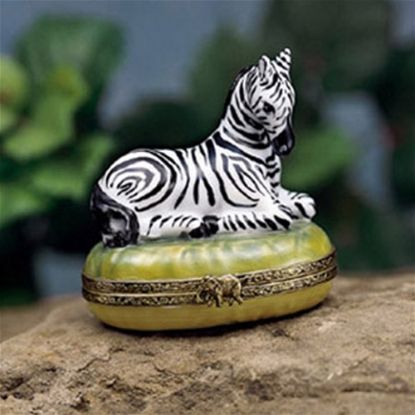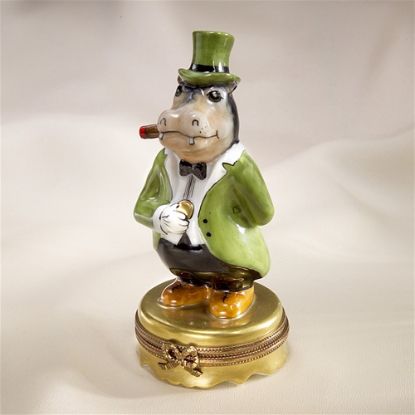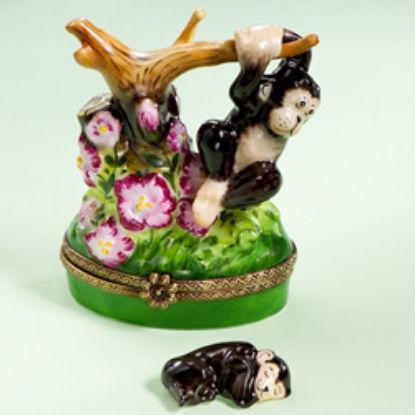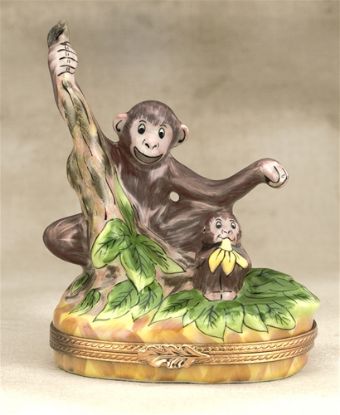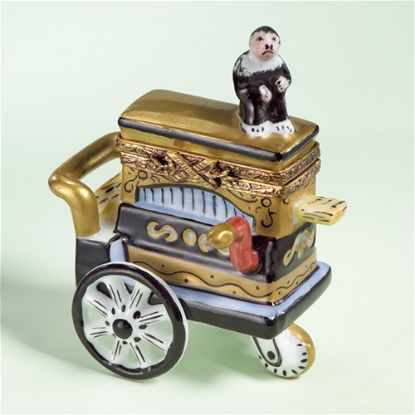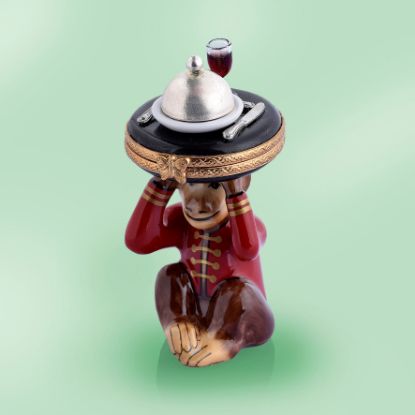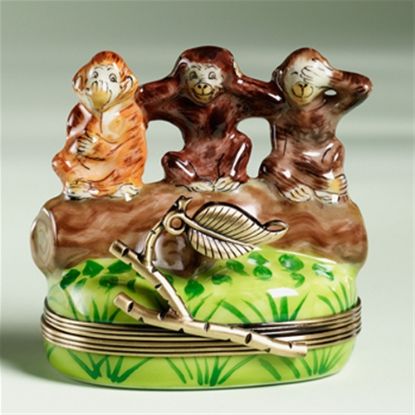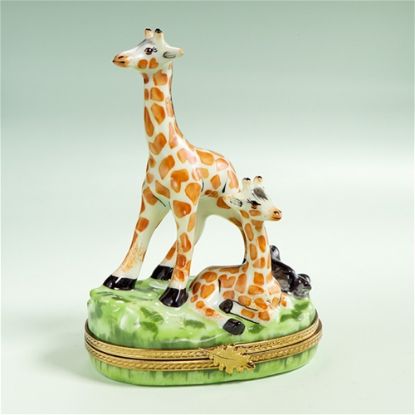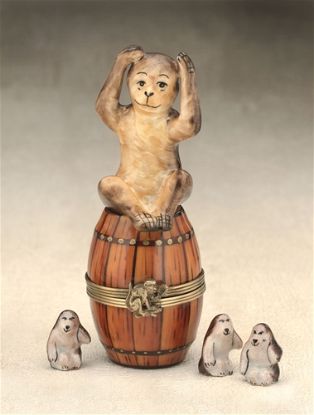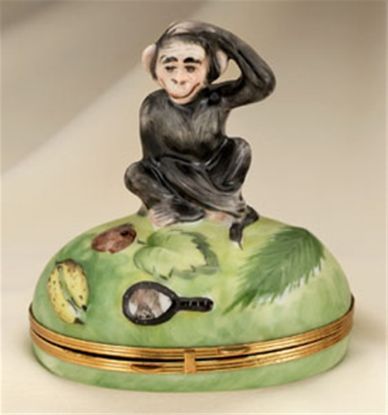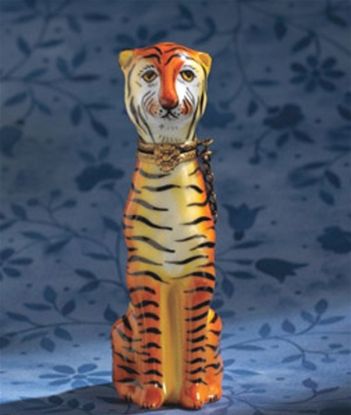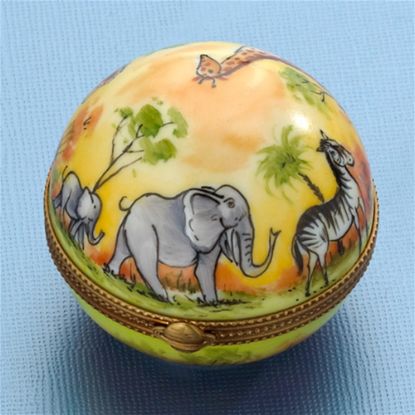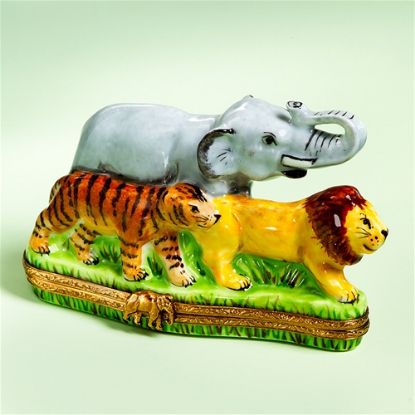Limoges Jungle Safari Animal Boxes
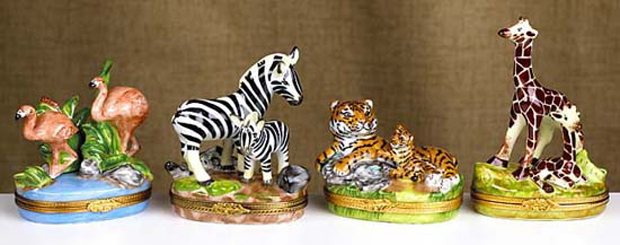
The Cottage Shop offers a variety of Limoges Jungle Safari Animal Boxes. Africa is home to many of the world’s fauna such as Lions, Rhinos, Giraffes, Leopards, Zebras, Cheetahs, and Elephants. The Afrotropical ecoregion lies mostly within the tropics and equally north and south of the equator. The African continent has deserts, coastlines, jungles, and grasslands which provide favorable conditions for wildlife.
The Limoges Jungle Animals Box depicts there of our largest animals walking proudly together on a green grass painted base.
The Limoges Round Safari Box has a painted scene of the various animals living together in the safari.
The Limoges Zebra Safari Car Box is painted with zebra stripes and includes a small porcelain card with a painted lion. This item is great for collectors of all ages!
The giraffe is a long necked mammal with long legs and an irregular unique pattern of brown patches on its light coat. Giraffes are the world’s tallest animal. Males can exceed 18 feet in height and weigh up to 4,250 pounds. Females are about 15 feet tall and weigh up to 2,600 pounds. Males and females have a pair of horns. Their tongues are around 1.5 feet long and they are able to take foliage from 19 feet off the ground. They feed on leaves, tree buds and shoots from trees. Areas with wild grass, plains, woodlands and savannas are suited for Giraffes. Giraffes are very social and will live in non-territorial groups of up to 20. Males will spend years in a bachelor group and engage in necking bouts to establish social hierarchy. Giraffes will gallop or engage in playful behavior when they are happy. They will live up to 26 years in the wild. The gestation period for a Giraffe is 15 months. A newborn giraffe is about 6 feet tall and weighs 220 pounds. In the ancient Egypt, Giraffes were kept by the pharaoh to show he had conquered foreign lands. Giraffe tails were prized to use for belts and jewelry. Over the centuries, Giraffes were hunted for their hide.
The Limoges Mother and Baby Giraffe Box has the unique painted patterns of the giraffe and has a mother proudly standing over her young.
The hippopotamus is a hairless amphibious mammal and is considered to be the 2nd largest land animal. They have a bulky body with stumpy legs. Males are usually 11.5 feet long and stand about 5 feet tall. They weight about 3.5 tons. Females are about 30% smaller. Their skin is about 2 inches thick on their flanks and thinner everywhere else. They are grayish brown with pink underparts. Hippopotamus are well adapted to water. Their ears, nostrils and eyes are located high on the head so they are able to submerge the rest of their body. Their dense body allows them to walk in water easily. They are also able to hold their breath for 5 minutes under water. Hippopotamus lose water quickly through their skin so they need to take frequent dips in the water. Their glands release an oily reddish secretion that acts as a sunblock that filters ultraviolet radiation. Some ancient Roman myths thought hippos sweat blood because of this. Hippos prefer to spend most of their days submerged in water. During the dry season, up to 150 hippos may be seen using one pool. At night, hippos will graze in the surrounding grasslands to feed for hours. They eat about 80 pounds of vegetation and are able to retain food in their stomach for an extended period of time. Their digestive cycle creates large quantities of nutrients for fish. Hippos are social and can live in a group of 20 to 100. The gestation period of hippos is about 8 months. The newborn calf weighs about 99 pounds. Since hippos trample and raid crops, they have been hunted for their hides and meat. Their teeth were also valued as fine-grained ivory that was easy to carve. In ancient Egypt, the hippopotamus was depicted with the deities associated with fertility and death. The goddess Taweret was depicted with a head and body of a pregnant hippo.
The Limoges Hippo Box is nicely painted to show the color variation of the hippo’s skin. The base is painted with part land and water.
The Limoges Gambler Hippo Box is designed for the hippo to be dressed like a man. This item is great for those collectors who enjoy animals dressed up like people.
The rhinoceros are giant-horn bearing herbivores. There are 6 species in the family Rhinocerotidae and they include some of the largest living land mammals. There are less than 30,000 of these 6 species left combined. Their horns are composed of keratin. Rhinos can range from 8 to 13 feet long and 5 to 7 feet tall. Adults can weigh up to 3-5 tons. They are known for their thick skin that forms like plate-like folds. Rhinos are brown or gray. They are mostly solitary and avoid each other except for the white rhino which lives in groups up to 10. Rhinos have an acute sense of smell and hearing. Rhinos will charge with little motivation. Black rhinos are ill-tempered and unpredictable. They can attain a speed of 30 mph and turn around rapidly if they missed a charge. Rhinos communicate using infrasonic frequencies. The gestation period is 16 months and the time between the births of calves range from 2 to 4.5 years. This would explain why the rhino population is slow to recover after the great loss from poaching. Tigers kill around 10-20% of calves under a year old. Once the calf reaches past 1 year old, they are no longer vulnerable to nonhuman predators. Rhinos have long been a victim to poaching for their horns. Traditional Chinese medicine uses powdered rhino horn as an anti-fever agent. In the Asian market, rhino horn commands tens of thousands of dollars per kilogram. In Persian mythology, the Karkadann was a ferocious mythical creature with one horn that lived in the grasslands and deserts of India, Persia and Northern Africa.
The Limoges Rhinoceros Box is painted to show the details of the rhinos muscular body and showcases the strength of this creature.
The zebra is a black and white striped mammal from the horse family. They are closely related to the domestic horse. Zebras stand about 4.5 feet tall. Zebras are all dark-skinned and the stripes arise from skin cells selectively determining the pigmentation of their fur. The black hair contains melanin and the white hair does not. The three species of Zebra are distinguished by their stripe pattern. Zebras live in small groups consisting of several mares and a stallion. Zebras will form a cluster around their young when threatened by a predator. Ancient African legends say that the zebra originally had a white coat and got it’s striped from fighting a baboon. During the fight, the zebra tripped on the fireplace and the ambers left black stripes on its fur.
The Limoges Mother and Baby Zebra Box is painted with the striking black stripes of the zebra.
The Limoges Zebra on Grass Box is a precious item with a zebra with its legs tucked under on a painted green base.
The lion is a large well-muscled cat from the family Felidae. The male has an outstanding golden mane that may fringe around the face or it may be full and shaggy. Some males have very dark manes. Adult males can range from 6-7 feet long excluding their 3 foot tail. They are about 4 feet tall and weigh between 370-500 pounds. The adult female is about 5 feet long and weighs between 260-395 pounds. Lions have a short haired coat that ranges from yellow, orange-brown to silvery gray, dark brown. They live in a group or pride which consists of several generations of females, a small number of males and their cubs. The average size of prides is around 15 members but can reach up to 37 members. Each pride has their own territory with a defined area that they defend against intruders. They mark this area by roaring and scent marking. Lions are more active at night and live in a variety of habitats. Females living in an open savanna do most of the hunting. The males obtain most of their meals from the female’s hunt. Males in wooded habitats spend more time hunting than with the females. Lions hunt a variety of animals of all sizes. Sometimes they hunt in groups circling and closing in on their prey. An adult male can eat over 75 pounds of meat in a meal. After meals, a lion will rest for a week before hunting again. Lions are polygamous and breed throughout the year. Females are restricted to one or two adult males in their pride. The gestation period is about 108 days. The litter size varies between 1 to 6 cubs. Once reaching sexual maturity, some of the female cubs will remain with the pride but the males will be expelled and become nomads. The lion population has dwindled over the centuries and some subspecies have died out. The International Union for the Conservation of Nature has listed lions as vulnerable. Lions are the most iconic animals on Earth and have been revered throughout history. In 1898, the Tsavo man-eaters were a pair of male lions that lived in Kenya. They devoured at least 35 men from the railroad bridge construction crew. They were hunted down and their skulls remain on display at the Chicago Field Museum. Founded in 1917, Metro-Goldwyn-Mayer film studio has used lions as their mascot. Their most famous lion is Leo which has been their longest running mascot since 1957. Leo was born in the Netherlands and brought to Hollywood as a young adult. He appeared in several films, commercials and television episodes. In Greek mythology, Hercules was tasked with killing the Nemean lion for the first of his twelve labors. The lion’s hide was impervious to blades so Hercules had to wrestle and strangle it. The Nemean lion is also presented as the constellation, Leo, which is one of the earliest recorded constellations.
The Limoges Lion and Lamb Box is a powerful symbol in Christianity and Judaism. The lion and the lamb explain the two comings of the Messiah. The first comes as the Lamb of God and the second as the Lion of Judah.
The Limoges Mother and Baby Lion Box is painted to show the color variations of the male’s mane as he stands over a lioness.
The tiger is the largest cat of the family Felidae. The Siberian tiger can measure up to 13 feet long and can weigh about 660 pounds. The Bengal tiger makes up about half of the total tiger population. The Bengal male can reach about 7 feet long with an additional 3 feet for the tail and weighs between 350 to 500 pounds. Sumatran and Indo-Chinese tigers are reddish tan with dark blackish vertical stripes. The Siberian tiger has pale longer fur. Tigers live in a variety of environments from the taiga to the Sundarbans. They inhabit ruins of buildings, dry grassland, and rainforests. Tigers hunt at night and prefer deer and wild pigs. After making a kill, tigers consume what they can and hide the rest from scavengers. This way they are able to get a second meal out of it. Tigers are solitary animals. They establish and maintain their own territories by vocalization, claw markings on trees, scrapings of the ground, scent deposits and spraying of urine. Mating is announced through vocalization and scent production by the females. The gestation period is 3.5 months and litters usually consist of 2-4 cubs. The cubs stay with their mother for about 2 years. They leave when they are able to hunt for themselves. Tigers live for about 11 years in the wild. Tigers have been poached for their skins and prized as trophies. In the 1970s, tiger hunting was banned in most countries and the tiger skin trade was outlawed. There are about 3200 tigers left in the wild and between 5,000-7,000 tigers living in captivity in the USA. Tigers are frequently portrayed in Asian art and lore. In the Chinese calendar, every 12 years is known as the year of the tiger and babies born on those years are considered lucky and powerful. Tiger parts have been used as talismans, tonics and medicine despite scientific evidence disproving their effectiveness. In Hindu mythology, the goddess Durga uses the tiger as her vehicle. In the ancient Indus civilization, tigers were represented on seals. In ancient India, Emperor Samudra minted gold coins depicting him slaying tigers.
The Limoges Mother and Baby Tiger Box depicts two young tigers playing. The base on this box is designed with the flora of the jungle.
The Limoges Tiger Mother and Baby Box depicts a mother tigers laying with a cub nestled next to her.
The monkey is a tailed primate that consists of 200 species. Their tale and narrow chest distinguishes them from apes. Monkeys usually have short flat faces with the exception of baboons and mandrills. New World Monkeys belong to five different families, have wide flat noses and live in the tropical rainforests of Central and South America. Old World Monkeys belong to one family, have typically hairless faces with forward downward nostrils, bare sitting pads, thumbs for dexterity and live in a wide range area in Africa and Asia. New World Monkeys spend their days active in bands looking for food. They sit upright and use their hands for tasks. Old World Monkeys mostly live in trees and leap from branch to branch. They use their hands and feet for grasping. Monkeys are highly intelligent and have large brains. They are able to solve complex problems and learn from their own experience. Even though they are brilliant, monkeys are not quite at the cognitive levels of apes. They are not able to learn from someone else’s experiences unlike apes. Monkeys live in troops that consist of several females with their young and either one male or several males. Throughout history, monkeys have been depicted in art to show man’s primal side. In 2018, a 4,400 year old tomb belonging to the priestess Hetpet was discovered in Egypt. The tomb had paintings of monkeys dancing around. Wall paintings uncovered from Bronze Age Greek artists depicted gray langur monkeys which gave a hint that ancient cultures were more intertwined than originally thought. In the early 18th century, paintings of monkeys in fashionable attire mimicking human behavior called singerie became popular in France. French decorator, Jean Berain, included this type of art in many of his arabesque wall decorations. In 1709, Claude III Audran painted a large portrait of monkeys seated at a table for the Chateau de Marly. In 1710, Jean Antoine Watteau painted The Monkey Sculptor in Rococo style. In 1747, the Meissen porcelain factory created a series of monkey orchestra figures called Affenkapelle ware. These figurines were believed to be a parody of the Dresden Court Orchestra.
The Limoges Safari Monkey Box is designed in a pith helmet, safari button down with trousers which makes this a humorous item for your collection!
The Limoges Three Monkeys Box represents the infamous Japanese pictorial maxim. The three monkeys are Mizaru who covers his eyes, Kikazaru who covers his ears and Iwazaru who covers his mouth.
The Limoges Monkey with Baby Box has a mother monkey holding a branch while its baby sits eating a banana.
- 1
- 2

